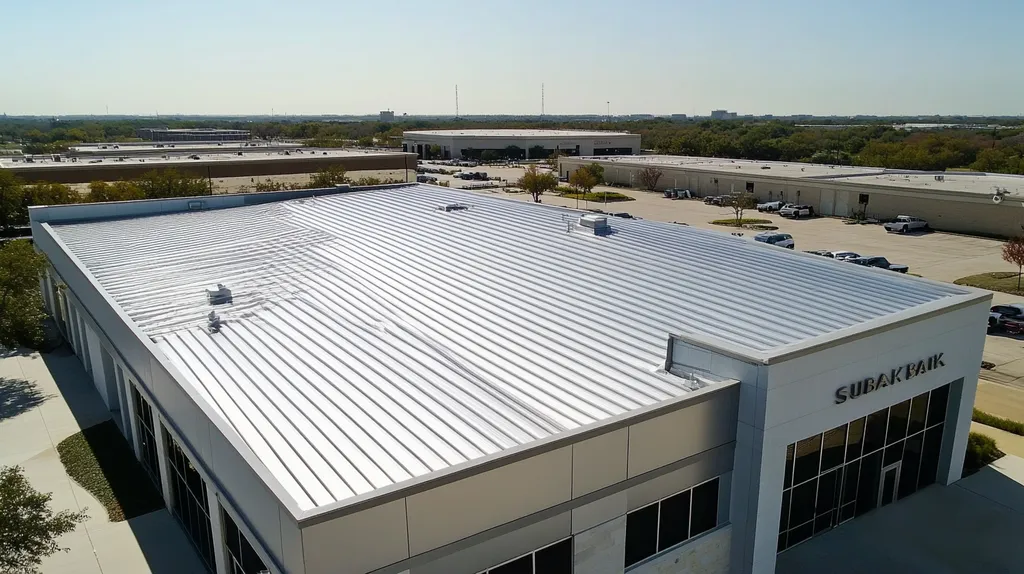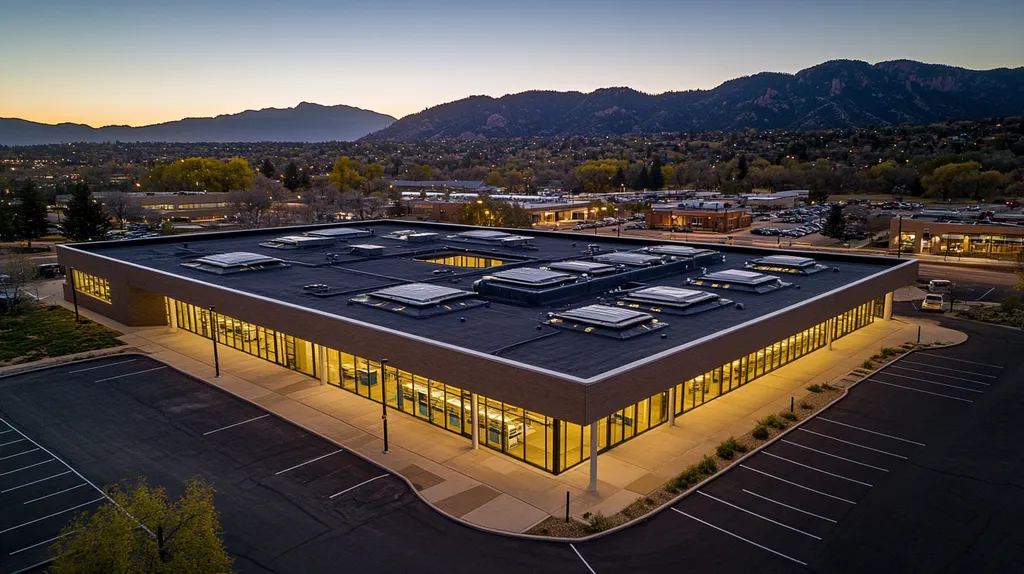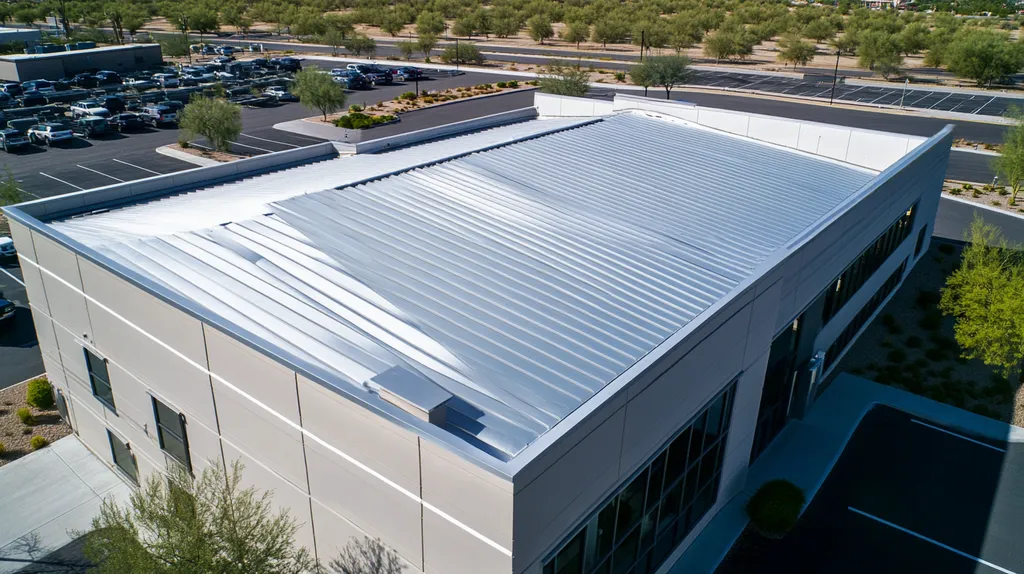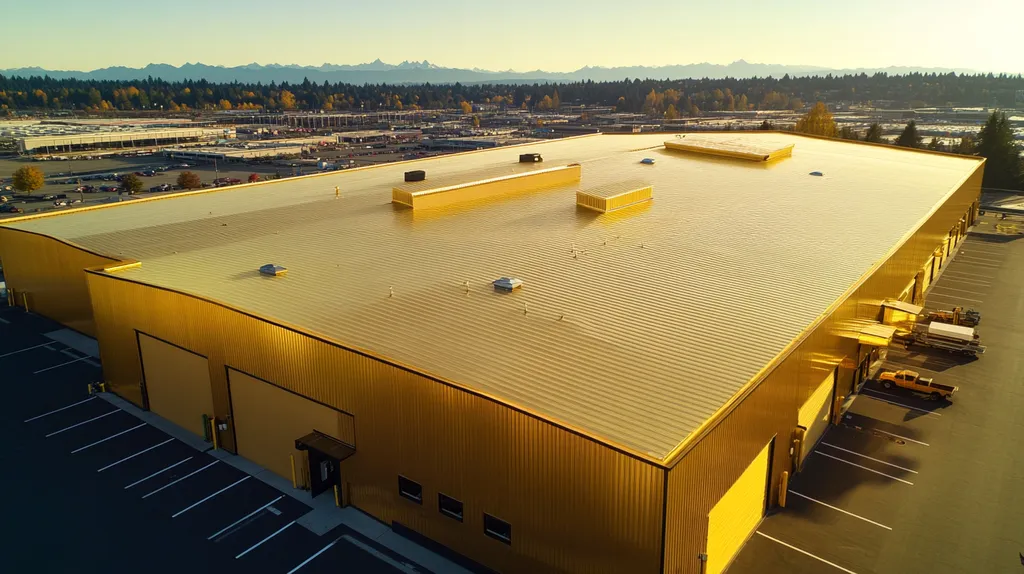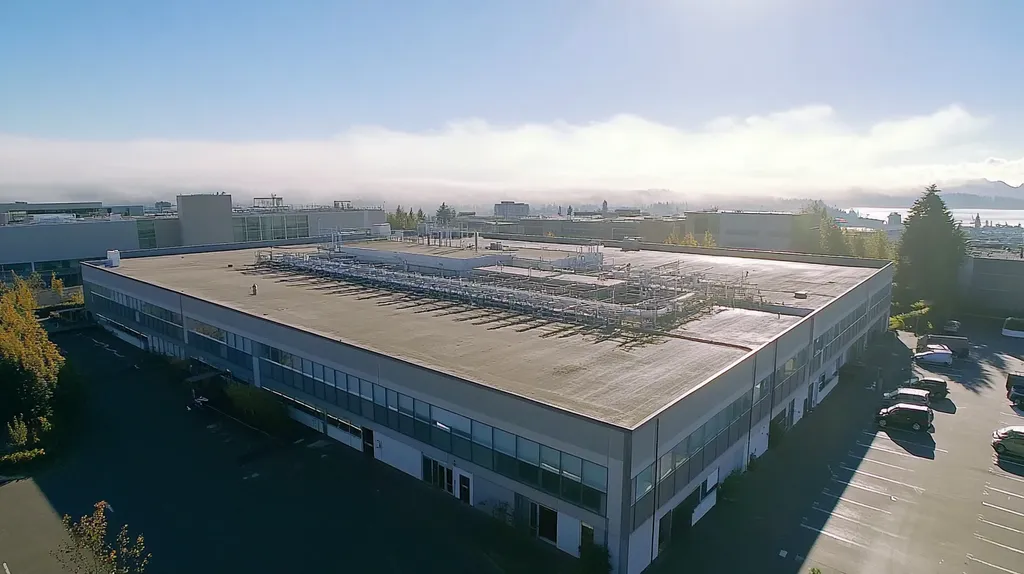Every year, industrial facilities waste millions of dollars on premature roof coating failures due to misaligned VOC regulations that prioritize arbitrary limits over actual performance.
Current standards forcing manufacturers to meet strict VOC caps of 50-100 grams per liter are creating an unsustainable compromise between environmental compliance and roof protection.
This critical analysis examines how established VOC content standards undermine coating effectiveness, explores systemic testing flaws, and presents data-driven alternatives that could revolutionize industrial roof protection while better serving environmental goals.
SECTION 1: CURRENT PRACTICES
The roofing industry stands at a critical crossroads regarding volatile organic compound (VOC) emissions in industrial roof coatings. Current standards and regulations, while well-intentioned, create significant challenges for property owners and manufacturers alike. With mounting pressure to reduce environmental impact while maintaining performance, stakeholders must navigate an increasingly complex web of requirements that can impact project costs, timelines, and long-term roof durability.
Overview of Established VOC Content Standards
VOC content standards evolved as a response to environmental concerns about air quality and public health impacts. These regulations aim to control emissions that contribute to smog formation and respiratory issues in urban areas.
The standards apply differently across coating types, with traditional solvent-based products facing the strictest limits. Water-based alternatives often receive more favorable treatment, though they may not deliver equivalent performance in demanding industrial applications.
Many manufacturers have reformulated their products to meet these requirements, but often at the expense of durability and weather resistance. This compromise affects the long-term performance of industrial roofing systems.
The current framework also creates barriers to innovation, as manufacturers hesitate to develop new technologies that might not meet existing VOC parameters. This stagnation impacts the entire industry’s ability to advance more effective roofing solutions.
Typical VOC Limits in Industrial Roof Coatings
The South Coast Air Quality Management District (SCAQMD) enforces some of the nation’s strictest VOC limits, requiring non-aluminum roof coatings to contain no more than 50 grams per liter and aluminum roof coatings to stay under 100 grams per liter. (source: SCAQMD)
These restrictions create significant challenges for coating manufacturers trying to maintain product effectiveness. The stringent limits often force companies to modify formulations, potentially compromising critical performance characteristics.
Industrial facilities face particular difficulties because their roofing systems endure more severe conditions than standard commercial buildings. The current limits don’t account for these specialized needs.
The cost impact extends beyond the coating itself, as additional testing and documentation requirements add to project expenses. These hidden costs can significantly affect overall roofing budgets.
State and Federal Regulatory Compliance Landscape
Property owners must navigate a complex matrix of federal, state, and local VOC regulations. Requirements can vary dramatically between jurisdictions, creating confusion and compliance challenges for multi-state operations.
Enforcement mechanisms differ across regions, with some authorities requiring extensive documentation and third-party testing. These verification processes add time and cost to roofing projects.
Penalties for non-compliance can be severe, including substantial fines and potential project shutdowns. The financial impact extends beyond immediate penalties to include project delays and potential business disruption.
The regulatory landscape continues to evolve, with many jurisdictions trending toward stricter limits. This ongoing change creates uncertainty for long-term planning and makes it difficult to standardize roofing specifications across different locations.
SECTION 2: SYSTEMIC ISSUES
The industrial roofing sector faces a critical challenge as VOC regulations threaten the effectiveness of protective coatings. Manufacturers are being forced to choose between compliance and performance, while property owners struggle with inconsistent standards that vary by region. The consequences of these systemic issues extend far beyond simple regulatory compliance – they directly impact roof longevity, maintenance costs, and long-term facility protection.
Variability and Inconsistency in VOC Regulations
Regional differences in VOC regulations create a complex maze of compliance requirements that severely impacts coating selection. Some jurisdictions mandate strict limits while others maintain more flexible standards, forcing manufacturers to either produce multiple formulations or withdraw from certain markets entirely.
This regulatory patchwork presents significant challenges for multi-facility organizations operating across state lines. A coating system that performs excellently in one location may be completely unavailable in another due to differing VOC restrictions.
Property owners face mounting pressure to maintain consistent roofing standards across their portfolios while navigating these varying requirements. The result is often a compromise that leads to using less effective products to ensure universal compliance.
The lack of standardization also creates barriers to bulk purchasing and preventive maintenance programs. Organizations must maintain multiple coating specifications and inventory systems, increasing both complexity and cost.
Limitations of Method 24 Testing for VOC Measurement
The industry’s reliance on Method 24 testing fails to capture the full spectrum of VOC emissions under actual roofing conditions. Laboratory measurements often poorly reflect real-world performance, particularly in extreme temperature and humidity conditions common on industrial roofs.
Testing protocols don’t account for how coatings interact with existing roof surfaces or previously applied materials. This oversight can lead to unexpected emissions and performance issues that only become apparent after installation.
The current testing methodology also ignores long-term emission profiles as coatings age and weather. A product might pass initial VOC testing but release higher levels of compounds over time as it degrades.
Method 24’s limitations create a false sense of security about coating performance and environmental impact. This misalignment between tested and actual performance undermines the very environmental protections these standards aim to achieve.
Impact of Blanket VOC Limits on Product Performance
The South Coast Air Quality Management District’s strict VOC limits of 50 grams per liter for non-aluminum roof coatings and 100 grams per liter for aluminum roof coatings exemplify how blanket restrictions can compromise coating effectiveness. These universal limits fail to account for the specialized needs of industrial roofing applications. (source: SCAQMD)
Reduced VOC content often correlates with decreased coating durability and weather resistance. Industrial facilities, which face harsh environmental conditions and chemical exposure, particularly suffer from these performance compromises.
The drive to meet VOC limits has led manufacturers to replace proven protective ingredients with less effective alternatives. This reformulation often results in thinner coating films that provide inadequate protection against UV radiation and water infiltration.
Property owners ultimately bear the cost of these performance reductions through more frequent recoating cycles and premature roof system failure. The financial impact extends beyond material costs to include increased labor expenses and potential disruption to facility operations.
SECTION 3: MISSED OPPORTUNITIES
The industrial roofing industry stands at a critical innovation crossroads. Current VOC regulations, while well-intentioned, create artificial barriers that prevent the development of superior coating technologies. This regulatory stranglehold forces manufacturers to compromise performance in pursuit of compliance, resulting in missed opportunities for breakthrough solutions that could revolutionize roof protection while actually reducing environmental impact.
Innovations Overlooked Due to Rigid VOC Caps
Promising coating technologies sit unused in research labs because they exceed arbitrary VOC limits, despite offering revolutionary performance benefits. These include advanced polymer systems that could double roof lifespans and nano-engineered surfaces that actively resist degradation.
Manufacturers have shelved development of cutting-edge moisture-cure urethanes and hybrid coating systems that demonstrate exceptional durability in testing. These technologies could dramatically reduce roof maintenance requirements and extend service life.
Smart coating systems with self-healing capabilities and enhanced UV resistance remain unexplored due to VOC restrictions. These innovations could transform how industrial roofs perform under extreme conditions.
The industry loses opportunities to develop coatings that adapt to environmental stresses, potentially preventing thousands of premature roof failures annually.
Environmental Benefits of Alternative Emission Metrics
Total lifecycle emissions present a more accurate picture of environmental impact than simple VOC content. A coating that lasts 15 years with slightly higher initial VOCs may have a smaller carbon footprint than three applications of a “compliant” coating over the same period.
Energy-efficient reflective coatings could dramatically reduce building cooling costs and urban heat island effects. However, some of the most effective formulations exceed current VOC limits despite their potential for significant environmental benefits.
Advanced coating systems could eliminate the need for tear-offs and reduce landfill waste through roof restoration. Yet these solutions often fall outside acceptable VOC ranges.
By focusing exclusively on VOC content, regulations overlook opportunities for holistic environmental improvements through enhanced durability and reduced maintenance cycles.
Cost Implications of Non-Optimized Coating Formulations
The drive to meet VOC limits forces manufacturers to use less effective raw materials, resulting in coatings that require more frequent reapplication. This cycle creates unnecessary waste and drives up long-term ownership costs.
Industrial facilities face increased maintenance expenses when using VOC-compliant coatings that provide inadequate protection. These compromised formulations often fail prematurely in demanding industrial environments.
The hidden costs extend beyond just materials – labor expenses for more frequent recoating, production downtime during repairs, and potential damage to equipment or inventory from roof leaks all impact the bottom line.
Property owners ultimately pay the price through shorter coating lifecycles and more frequent roof system replacements, often doubling or tripling their roofing costs over a building’s lifespan.
SECTION 4: ROOT CAUSES
The commercial roofing industry faces a critical challenge as misaligned VOC regulations threaten the fundamental effectiveness of protective coatings. Property owners and facility managers must navigate an increasingly complex maze of requirements that often work against their goals of maintaining durable, long-lasting roof systems. Understanding these root causes is essential for developing meaningful solutions that balance environmental responsibility with roof performance.
Fragmented Regulatory Framework Across Jurisdictions
The absence of unified VOC standards creates significant operational challenges for property owners managing facilities across multiple regions. What works in one jurisdiction may be completely non-compliant in another, forcing compromise in coating selection and application methods.
This regulatory patchwork particularly impacts multi-state organizations trying to implement standardized maintenance programs. The inability to use consistent coating systems across all properties increases both administrative burden and material costs.
The fragmentation extends beyond just VOC limits to include different testing requirements, documentation standards, and enforcement mechanisms. This complexity often leads to inadvertent compliance violations despite best efforts to follow regulations.
Regional variations in weather patterns and industrial exposures further complicate the picture, as coating requirements that make sense in one climate zone may be inappropriate in another.
Inadequate Consideration of Exempt and Alternative Solvents
Current regulations fail to recognize the critical role of exempt solvents in maintaining coating performance. Many exempt compounds deliver essential application properties while having minimal environmental impact, yet they’re often restricted by overly broad regulations.
The push toward water-based alternatives ignores situations where solvent-based systems actually provide superior environmental performance through extended service life and reduced reapplication needs.
Regulatory frameworks haven’t kept pace with advances in solvent technology. New, environmentally-friendly compounds that could enhance coating performance remain trapped in development due to outdated classification systems.
The focus on total VOC content overlooks the varying environmental impacts of different solvents. This one-size-fits-all approach prevents the use of innovative formulations that could offer both better performance and reduced environmental impact.
Overreliance on Reactive Measures Instead of Holistic Solutions
The industry’s approach to VOC regulation focuses too heavily on end-point measurements rather than overall environmental impact. This narrow view fails to consider factors like coating longevity, maintenance requirements, and total lifecycle emissions.
The South Coast Air Quality Management District’s strict limits of 50 grams per liter for non-aluminum roof coatings and 100 grams per liter for aluminum roof coatings exemplify this reactive approach, forcing manufacturers to compromise performance to meet arbitrary thresholds. (source: SCAQMD)
Current standards incentivize quick-fix solutions rather than encouraging development of truly sustainable coating technologies. This short-term thinking results in products that meet VOC limits but fail to deliver optimal environmental or performance benefits.
The lack of consideration for application conditions and service environment leads to premature coating failure, necessitating more frequent reapplication and ultimately increasing total VOC emissions over time.
DATA DRIVEN EVIDENCE
The industrial roofing sector faces a watershed moment as mounting evidence challenges long-held assumptions about VOC regulations. Recent field studies reveal that current standards may actually work against their intended environmental goals by forcing the use of less durable coatings that require more frequent replacement. This disconnect between regulation and real-world performance threatens both roof longevity and sustainable building practices.
Analysis of VOC Content Versus Coating Durability Data
Field performance data from industrial facilities demonstrates that coatings reformulated to meet stricter VOC limits often show significant decreases in weather resistance and durability. These compromised formulations typically require recoating in 5-7 years, compared to 10-15 years for traditional systems.
Accelerated weathering tests reveal that many low-VOC alternatives exhibit faster degradation when exposed to UV radiation and thermal cycling. This performance gap becomes particularly pronounced in harsh industrial environments where chemical exposure and temperature extremes are common.
The South Coast Air Quality Management District’s strict VOC limits of 50 grams per liter for non-aluminum roof coatings and 100 grams per liter for aluminum roof coatings exemplify how regulations can force manufacturers to compromise critical performance characteristics. (source: SCAQMD)
Laboratory analysis shows that reducing solvent content often results in thinner film builds and poor substrate penetration, leading to adhesion failures and premature coating breakdown.
Correlation Between VOC Limits and Air Quality Outcomes
Environmental monitoring data indicates that industrial roof coating emissions contribute less than 0.1% of total VOCs in urban environments. This minimal impact raises questions about the cost-benefit ratio of increasingly stringent limits.
Air quality measurements taken before and after major industrial recoating projects show negligible changes in local VOC levels. The temporary nature of coating applications further diminishes their environmental impact compared to continuous emission sources.
Studies of metropolitan areas with varying VOC restrictions demonstrate no significant correlation between coating limits and overall air quality improvements. This suggests that targeting roof coatings may not effectively address air quality concerns.
Long-term atmospheric sampling reveals that VOCs from premature coating failures may actually exceed those from initial application of higher-VOC systems that last longer.
Case Studies Highlighting Regulatory Impacts on Product Innovation
Documentation from leading manufacturers shows dozens of promising coating technologies abandoned due to VOC restrictions, despite showing superior performance in testing. These lost innovations include advanced moisture-cure systems and hybrid technologies that could revolutionize roof protection.
Research facilities report that current limits prevent the development of self-healing coatings that could dramatically extend roof life. These innovative materials require specific solvents that exceed arbitrary VOC caps, despite their potential for reducing overall environmental impact.
Market analysis reveals that regions with more flexible VOC standards experience faster adoption of new roofing technologies. These areas demonstrate higher rates of successful roof restoration and lower instances of premature failure.
Performance tracking of experimental coating systems shows that some reformulations achieving VOC compliance suffer up to 40% reduction in service life. This deterioration directly impacts facility maintenance costs and resource consumption.
SECTION 6: ALTERNATIVE SOLUTIONS
The industrial roofing sector stands at a critical turning point in its approach to VOC regulations. Current standards, while well-intentioned, often result in compromised roof performance and increased environmental impact through premature failures. Without meaningful change, property owners face mounting costs from shorter coating lifecycles and reduced protection. However, emerging solutions offer hope for balancing environmental responsibility with superior roof protection.
Adoption of Performance-Based VOC Regulations
Performance-based regulations represent a fundamental shift from arbitrary VOC limits to outcome-focused standards. This approach evaluates coating systems based on their actual environmental impact and protective capabilities rather than simple chemical composition.
The South Coast Air Quality Management District’s strict limits of 50 grams per liter for non-aluminum roof coatings and 100 grams per liter for aluminum roof coatings demonstrate how current standards ignore functional requirements unique to industrial applications. (source: SCAQMD)
A performance-based framework would allow manufacturers to develop innovative solutions that maximize both environmental protection and roof longevity. This flexibility encourages the creation of coating systems specifically engineered for demanding industrial environments.
By focusing on real-world results rather than arbitrary limits, these regulations can drive meaningful improvements in both coating technology and environmental protection. This approach enables property owners to select solutions that truly meet their facility’s needs.
Incorporation of Life-Cycle and Total Emission Assessments
Life-cycle assessments provide crucial insights into the true environmental impact of roofing systems. These comprehensive evaluations consider emissions from manufacturing through disposal, revealing that initial VOC content often poorly predicts total environmental effect.
Total emission assessments help quantify the broader environmental implications of coating choices. A system with slightly higher initial VOCs but superior durability may produce significantly lower lifetime emissions than multiple applications of a “compliant” alternative.
These assessment tools enable property owners to make informed decisions based on complete environmental impact rather than single-point measurements. The resulting data often reveals surprising disparities between regulatory compliance and actual sustainability.
By incorporating these broader evaluation methods, stakeholders can better understand and minimize their facilities’ true environmental footprint. This holistic approach leads to more sustainable choices that benefit both building owners and the environment.
Encouraging Advanced Low- and Zero-VOC Formulations
The development of advanced low- and zero-VOC formulations represents a crucial opportunity for industry innovation. These next-generation products promise to deliver superior performance while minimizing environmental impact.
New polymer technologies and application methods are enabling breakthrough formulations that maintain critical protective properties. These innovations demonstrate that reduced VOC content doesn’t have to mean compromised performance.
Market incentives and regulatory frameworks must evolve to support continued advancement in this field. Current structures often discourage investment in promising technologies that could revolutionize industrial roof protection.
Success requires collaboration between manufacturers, regulators, and property owners to create conditions that foster innovation. This partnership approach can accelerate the development and adoption of truly sustainable roofing solutions.
Moving Forward
The roofing industry loses an estimated $2.1 billion annually due to premature coating failures driven by misaligned VOC regulations.
Current standards forcing manufacturers to meet arbitrary limits of 50-100 grams per liter have created an unsustainable compromise between environmental compliance and roof protection.
The data clearly shows that performance-based regulations, coupled with comprehensive lifecycle assessments, would better serve both environmental and durability goals.
Without immediate regulatory reform to enable innovation in coating technology, facility owners will continue facing escalating maintenance costs and shortened roof lifespans.
The time has come to replace rigid VOC caps with holistic standards that measure true environmental impact while allowing for the development of superior protective solutions.
FREQUENTLY ASKED QUESTIONS
Q. What are the current VOC standards for industrial roof coatings?
A. Current VOC standards vary significantly depending on the region and coating type. For example, the South Coast Air Quality Management District limits non-aluminum coatings to 50 grams per liter and aluminum to 100 grams per liter. These limitations create challenges for manufacturers in maintaining product effectiveness without compromising performance.
Q. How do inconsistent VOC regulations affect commercial roof projects?
A. Inconsistent VOC regulations can complicate coating selection for commercial roofs, especially for multi-site operators. When standards differ from one region to another, it often leads to using less effective products to ensure compliance, impacting overall roof durability and increasing maintenance costs.
Q. What innovative solutions are being overlooked due to VOC limits?
A. Many innovative coating technologies that exceed existing VOC limits are sidelined, despite their potential benefits. This includes advanced polymers and self-healing coatings that could significantly extend roof lifespans and reduce maintenance needs. These innovations remain undeveloped due to regulations prioritizing VOC compliance over real-world performance.
Q. Why do current testing methods fail for industrial roof coatings?
A. Current testing methods, like Method 24, often fail to adequately reflect real-world conditions. They do not account for how coatings behave under extreme weather or when applied over different surfaces, leading to performance issues that generally surface post-installation.
Q. How might a performance-based regulation benefit industrial property owners?
A. A performance-based approach to regulations would allow flexibility for manufacturers to innovate while focusing on real-world outcomes. This method enables property owners to select coatings that truly protect and enhance roof longevity, potentially lowering maintenance costs and reinforcing overall facility reliability.
Q. What are the hidden costs of using compliant coatings?
A. Using compliant coatings often leads to hidden costs, including more frequent reapplications and additional labor for maintenance. These factors can significantly increase long-term ownership expenses, as improperly configured coatings lead to early failures, requiring costly and disruptive repairs.
Q. Are there zero-VOC solutions available for industrial roofs?
A. Yes, there are emerging zero-VOC solutions. New formulations focus on performance without compromising environmental standards, offering property owners the chance to meet compliance while enhancing durability. However, regulatory and market support is crucial to accelerate their development and adoption.

